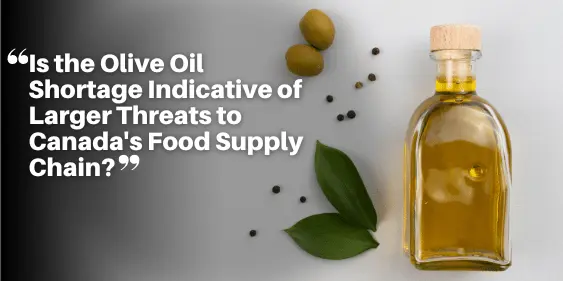Is the Olive Oil Shortage Indicative of Larger Threats to Canada’s Food Supply Chain?
By: Emilly Correa Posted in: August 19, 2024 Last Update: August 13, 2025

In recent months, the specter of an olive oil shortage has loomed large over Canada, affecting businesses and consumers alike.
Emilio Pulla, a Toronto-based wholesaler, has been closely monitoring weather patterns in Italy for nearly a year.
His concern stems from the detrimental impact of extreme weather conditions on olive tree blossoms, which have significantly reduced yields and subsequently driven up prices in the Canadian market.
The volatility in supply has left wholesalers like Pulla grappling with unpredictable pricing and availability, creating challenges in meeting consumer demand.
The prolonged drought and intense heatwaves in key olive-producing regions have exacerbated the situation, leading to diminished harvests and increased production costs.
Pulla’s observations underscore a broader concern among industry experts about the vulnerability of global supply chains to climate-related disruptions.
As Canada navigates these uncertainties, stakeholders are compelled to explore sustainable solutions and strengthen resilience measures to safeguard against future shocks in the food supply chain.
The Root of the Crisis: Climate Change and Extreme Weather
The root cause of this crisis, according to Geneviève Grossenbacher, director of policy at Farmers for Climate Solutions in Ottawa, is climate change.
Extreme heatwaves and insufficient rainfall in major olive oil-producing countries like Spain and Italy have ravaged olive crops.
This phenomenon is not isolated; it reflects a broader pattern of climate-induced disruptions affecting global food supply chains.
According to Copernicus, the European Union’s climate monitoring body, Europe is experiencing unprecedented heatwaves that surpass human tolerance levels.
These environmental challenges have cascading effects, impacting not only olive oil production but also other agricultural sectors crucial for global food security.
Economic Ripples: Impact on Canadian Consumers and Businesses
The shortage has had tangible effects on the Canadian market.
Pulla notes that wholesale prices of extra virgin olive oil in the Greater Toronto Area have skyrocketed from $5-$7 per liter to over $20 per liter.
Such price hikes force consumers and businesses, including restaurants, to rethink their purchasing habits, often opting for blends that incorporate cheaper oils like canola or soy.
Looking ahead, Pulla remains cautiously optimistic.
Reports from Italian suppliers suggest a potential easing of the crisis with anticipated rainfall, hinting at a possible price decrease in the coming months.
Nevertheless, the long-term sustainability of olive oil prices remains uncertain, contingent upon global weather patterns and agricultural practices.
Beyond Olive Oil: Global Food Security at Risk
The olive oil shortage serves as a microcosm of larger threats looming over global food security.
A 2022 report highlights that a significant portion of the world’s calories originates from staple crops such as wheat, rice, maize, and soybeans, predominantly grown in a handful of countries.
The concentration of food production in these regions poses substantial risks in the face of climate change-induced disasters.
The report warns of potential synchronized production shocks, where multiple countries simultaneously experience crop failures due to extreme weather events.
Recent examples in Canada, including devastating droughts and wildfires in Western Canada, underscore the vulnerability of food production to climate variability.
Canada’s Vulnerability and Adaptation Strategies
Canada itself has not been immune to these challenges.
Western Canada, in particular, faced severe agricultural losses in recent years due to a combination of extreme weather events.
The impact on staple crops like wheat and canola has been profound, leading to significant economic losses and threatening food security domestically.
Grossenbacher emphasizes the urgent need for Canada to enhance climate resilience in its agricultural practices.
Proposed measures include investing in irrigation infrastructure, promoting drought-tolerant farming techniques, and expanding greenhouse facilities for year-round production.
Moreover, fostering knowledge-sharing among farmers and bolstering crop insurance coverage are crucial steps toward safeguarding agricultural livelihoods against climate-related risks.
The Role of Government and Societal Investment
As Canada grapples with the aftermath of olive oil shortages and other climate-induced agricultural crises, Grossenbacher calls for decisive government action.
She advocates for increased financial support to mitigate crop losses and facilitate transitions toward sustainable agricultural practices.
Furthermore, she urges Canadians to consider broader societal choices regarding climate adaptation and the promotion of low-emission agricultural methods.
Conclusion: A Call to Action
The olive oil shortage serves as a stark reminder of the interconnectedness of global food systems and the vulnerability of Canada’s food supply chain to climate change.
It prompts critical reflections on resilience-building measures and the imperative of sustainable agricultural practices.
As stakeholders across sectors navigate these challenges, proactive investment in climate adaptation strategies emerges as a pivotal pathway toward securing Canada’s food future.
In conclusion, while the current olive oil crisis unveils immediate challenges, it also underscores opportunities for innovation and collaboration in building a more resilient and sustainable food system for Canada and beyond.
Author
-

Emilly Correa has a degree in journalism and a postgraduate degree in digital marketing, specializing in content production for social media. With experience in copywriting and blog management, she combines her passion for writing with digital engagement strategies. She has worked in communications agencies and now dedicates herself to producing informative articles and trend analyses.






